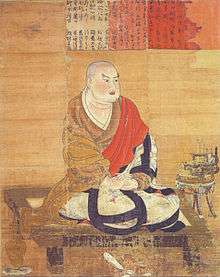Kuiji
| Kuiji 窺基 | |
|---|---|
 | |
| Religion | Buddhism |
| School | East Asian Yogācāra |
| Personal | |
| Born |
632 Chang'an, China |
| Died | 682 (aged 50) |
| Religious career | |
| Teacher | Xuanzang |
Kuījī (simplified Chinese: 窥基; traditional Chinese: 窺基; 632–682), also known as Ji (Chinese: 基),[2] an exponent of Yogācāra, was a Chinese monk and a prominent disciple of Xuanzang.[3] His posthumous name was 慈恩大師 Cí'ēn dàshī, The Great Teacher of Cien Monastery, after the 大慈恩寺 or Great Monastery of Compassionate Grace, which was located in Changan, the main capital of the Tang Dynasty. The Giant Wild Goose Pagoda (Dayanta 大雁塔) was built in 大慈恩寺 in 652.
Kuiji's commentaries on the Cheng weishi lun and his original treatise on Yogācāra, the Fayuan yilin chang 大乘法苑義林章 ("Essays on the Forest of Meanings in the Mahāyāna Dharma Garden" became foundations of the Weishi or Faxiang School.[3]
The Faxiang School consider Kuiji to be their first patriarch.[3]
Works
Commentaries
- Amitābha and Maitreya Sūtras
- Diamond Sūtra
- Heart Sūtra (般若波羅蜜多心經幽贊). Translated by Shih and Lusthaus (2006).
- Lotus Sūtra (Fahua xuanzan, "Profound Panegyric to the Lotus Sūtra")[4]
- Vimalakīrtinirdeśa-sūtra (說無垢稱經疏)
Buddhist logic
- Buddhist logic - Great Commentary on the Nyayapravesa ( 因明入正理論疏)
Commentaries specific to Yogacara
- Madhyāntavibhāga ( 辯中邊論述記)
- Sthiramati's Commentary on Asaṅga's Abhidharmasamuccaya (雜集論述記)
- Vasubandhu's Twenty Verses (Viṃśatikā)(唯識二十論述記)
- Vasubandhu's One Hundred Dharmas Treatise ( 大乘百法明門論解)
- Yogācārabhūmi ( 瑜伽師地論略纂)
Notes
| Wikimedia Commons has media related to Kuiji. |
- ↑ De Visser, Marinus Willem (1935). Ancient Buddhism in Japan. E. J. Brill. p. 442.
- ↑ "中国历史上排名第二的高僧究竟叫什么名字?" (in Chinese). The Paper. 20 December 2015. Retrieved 20 December 2015.
- 1 2 3 Lusthaus, Dan (undated). Quick Overview of the Faxiang School 法相宗. Source: (accessed: December 12, 2007)
- ↑ Buswell, Robert Jr; Lopez, Donald S. Jr., eds. (2013). Princeton Dictionary of Buddhism. Princeton, NJ: Princeton University Press. p. 291. ISBN 9780691157863.
References
- Shih, Heng-Ching & Lusthaus, Dan. (2006) A Comprehensive Commentary on the Heart Sutra (Prajnaparamita-hyrdaya-sutra). Numata Center for Buddhist Translation & Research.
- Lusthaus, Dan (undated). Quick Overview of the Faxiang School 法相宗. Source: (accessed: December 12, 2007)